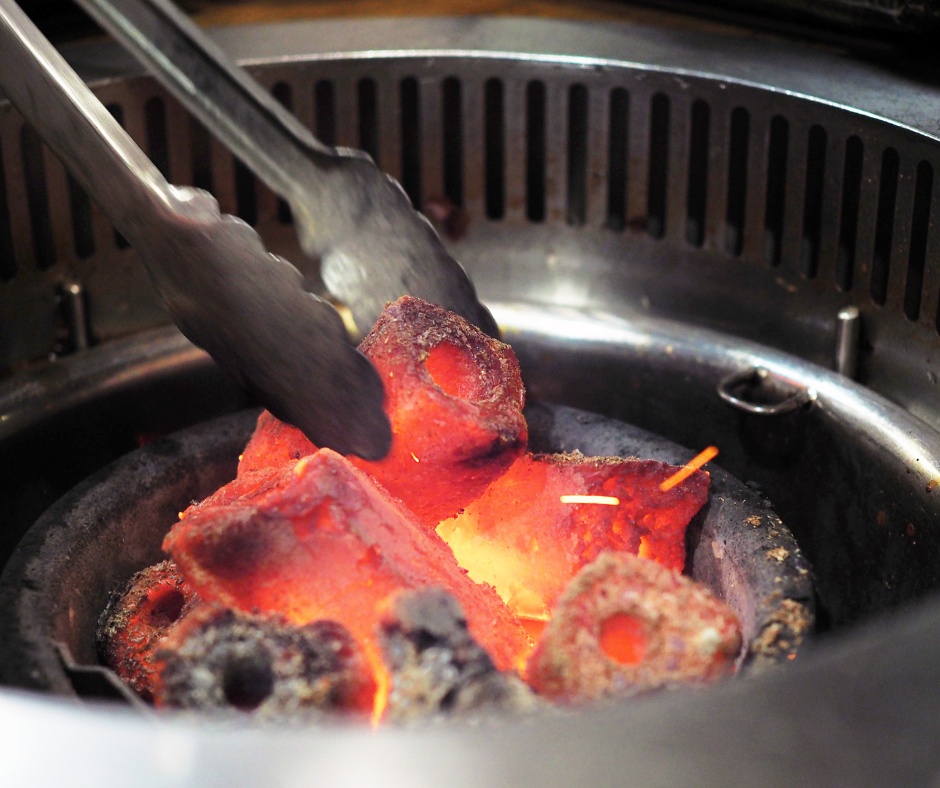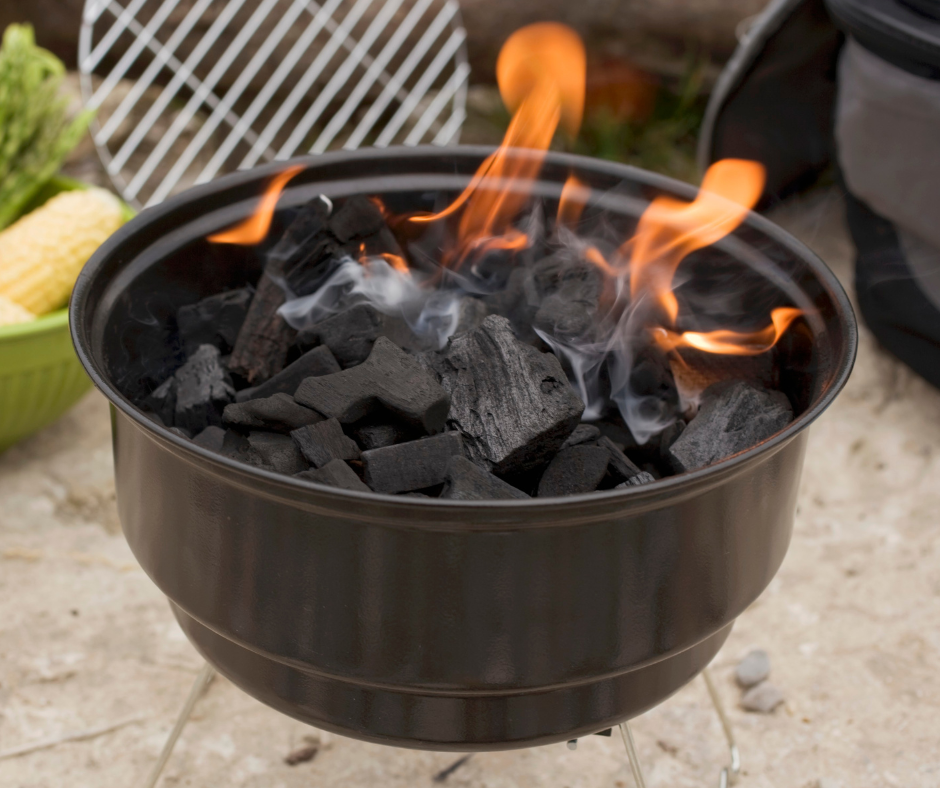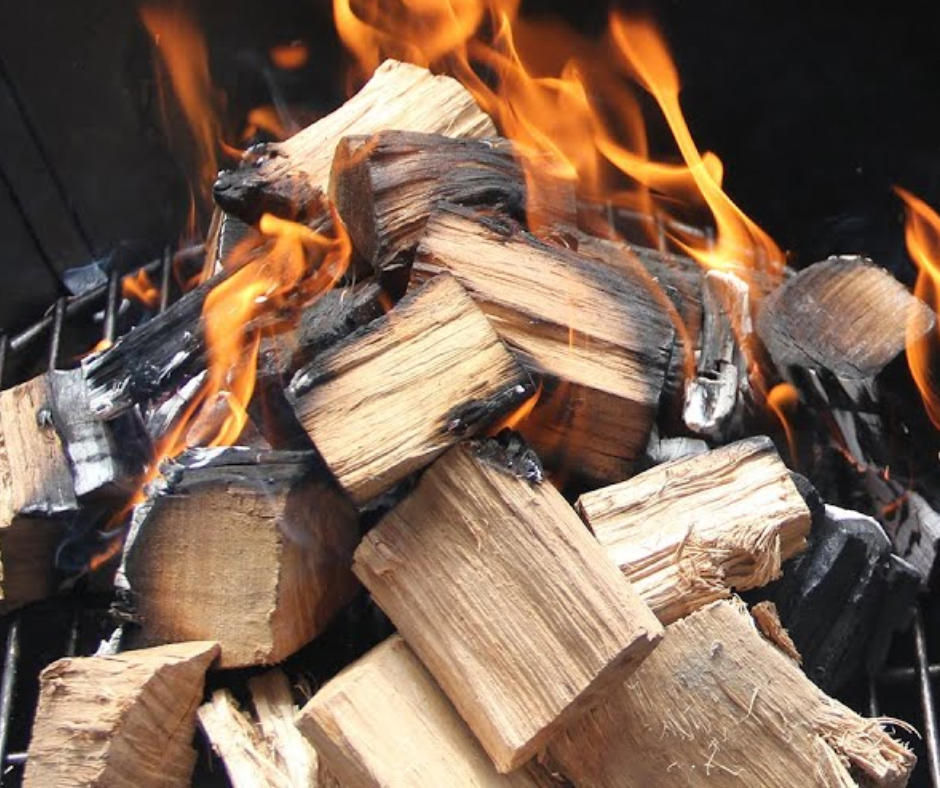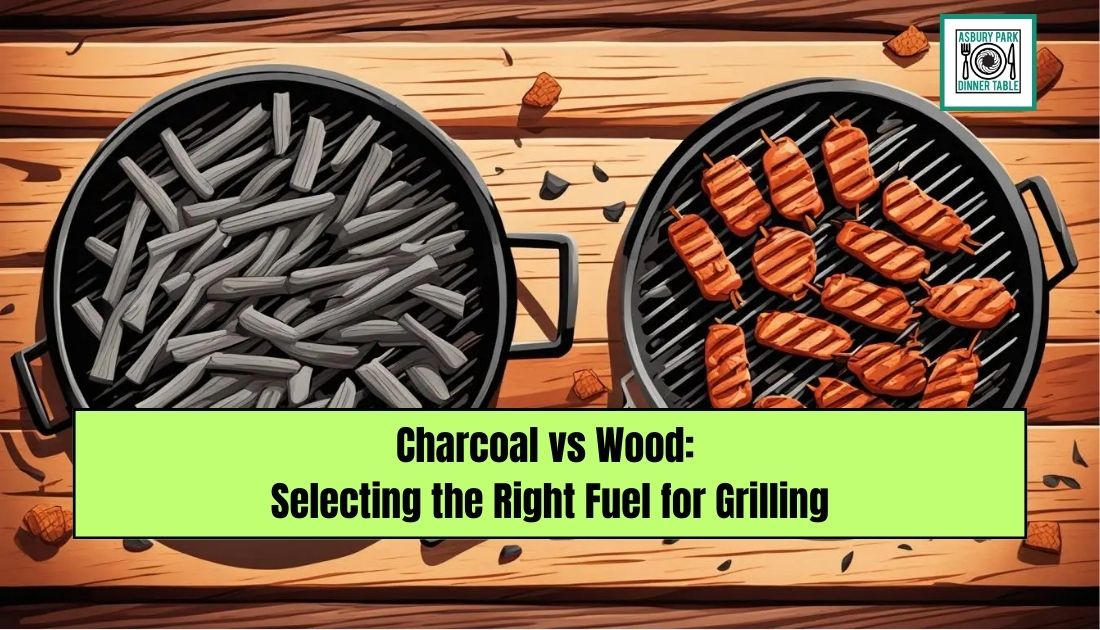Introduction
Grilling is more than just a way to cook food—it’s a beloved tradition that brings families and friends together. When it comes to grilling, choosing the right fuel is essential to achieving the perfect cookout experience. Two popular options are charcoal and wood, each with its unique benefits. In this article, we will explore the importance of selecting the right fuel for grilling and compare the pros and cons of Charcoal vs Wood so you can make an informed decision.

The Importance Of Choosing The Right Fuel For Grilling
The fuel you choose for grilling can significantly impact the taste, flavor, and cooking process. It’s not just about heating your food; it’s about achieving that smoky, mouthwatering flavor that grilling enthusiasts crave. Whether you’re a seasoned griller or a novice, the right fuel can make all the difference in the quality of your cookout.
Regarding charcoal vs. wood, there are key factors to consider. Charcoal allows for a hotter and longer cooking fire without adding more fuel. The flavor imparted by charcoal grilling is more well-rounded than gas, making it a popular choice for those seeking that traditional smoky flavor. On the other hand, wood grilling offers a unique, distinct flavor profile that can elevate your dishes to new heights. However, wood grilling requires more effort and maintenance compared to charcoal.
In addition to taste, budget, convenience, and the type of grilling experience you desire, these are also important factors to consider. Charcoal grilling is usually cheaper and more readily available, making it a convenient option for those who want a quick and easy grilling experience. Wood grilling, while expensive, offers a more authentic and unique flavor that some grillers are willing to invest time and effort in.
Choosing charcoal and wood grilling depends on your preference and the experience you want to create for yourself and your guests. Both options have their advantages and can result in delicious meals. The key is to choose the fuel that aligns with your taste, budget, and grilling goals. So go ahead, fire up the grill, and let the sizzling aroma of your chosen fuel take your outdoor cooking adventures to the next level.
Understanding Charcoal
Types Of Charcoal: Briquettes And Lump Charcoal
There are two main types of charcoal commonly used for grilling: briquettes and lump charcoal. Briquettes are compressed charcoal dust mixed with binding agents, resulting in consistent shapes and sizes. They provide a steady and controlled heat source, making them ideal for long cooking sessions. Lump charcoal, on the other hand, is made from chunks of pure hardwood that have been burned down to carbon. It doesn’t contain additives and ignites quickly, offering an intense heat perfect for searing.
Pros And Cons Of Grilling With Charcoal
Grilling with charcoal has its own set of advantages and disadvantages that you should consider. One of the main benefits is the unique smoky flavor that charcoal imparts to the food. This flavor is highly sought after by many grilling enthusiasts. Additionally, charcoal grills can reach higher temperatures than gas grills, allowing for excellent searing and creating those coveted grill marks.
However, grilling with charcoal requires more time and effort than other fuel options. It takes time to light the charcoal and bring it to the desired temperature. It also requires regular maintenance, such as cleaning out the ashes. Another point to consider is that charcoal grills are less portable than others.
Ultimately, the best option will depend on your specific needs and the type of cooking experience you want to create. If you prioritize flavor and are willing to invest time and effort, charcoal may be your perfect choice. On the other hand, if convenience and portability are more important, you may lean towards other fuel options. So fire up the grill, choose your fuel wisely, and enjoy the delicious flavors that charcoal or wood can bring to your next outdoor cooking adventure.

Exploring Wood As A Fuel Option
Choosing the right fuel for grilling can greatly impact the taste and overall experience. While charcoal is popular, some grill masters prefer the more traditional and natural wood option. Let’s take a closer look at wood as a fuel option, including the different types of wood for grilling and the benefits and drawbacks of using it.
Different Types Of Wood For Grilling
Various types of wood grilling can add distinct flavors to your food. For example, mesquite wood imparts a strong and smoky flavor, perfect for grilling meats, while fruitwood like apple and cherry adds a subtle sweetness that pairs well with poultry and pork. On the other hand, Oakwood provides a rich and hearty flavor that is great for grilling beef.
Benefits And Drawbacks Of Using Wood For Grilling
Using wood as your fuel source can elevate the taste of your grilled dishes, adding a unique and natural smoky flavor that charcoal cannot replicate. Wood burns at a higher temperature, allowing for a quicker and more intense sear on your meats.
However, there are a few drawbacks to consider when using wood for grilling. First, wood can be more difficult to control regarding temperature and ignition. It requires more skill and attention to maintain a steady cooking temperature. Wood can also be more expensive and harder to source than charcoal.
Ultimately, the choice between charcoal and wood for grilling comes down to personal preference. If convenience and ease of use are top priorities, then charcoal may be the better option. But for those seeking a unique and natural smoky flavor and the challenge and satisfaction of mastering wood grilling, using wood as your fuel choice can take your grilling game to the next level.
So, whether you decide to stick with the convenience of charcoal or embark on an adventurous journey with wood grilling, the most important thing is to enjoy the process and savor the delicious flavors each fuel option brings to your outdoor cooking adventures. Happy grilling!
Charcoal vs Wood
When it comes to grilling, choosing charcoal and wood fuel can greatly impact the taste and overall grilling experience. Let’s delve into the differences when comparing Charcoal vs Wood to help you select the right fuel for your next cookout.
Taste Differences Between Charcoal And Wood-grilled Food
Both options have unique characteristics that can enhance the taste of your food. Charcoal grilling produces a smoky, rich flavor that many grill aficionados love. The intense heat from the charcoal imparts a distinctive charred taste to the meat, creating a mouthwatering experience.
On the other hand, wood grilling offers a more intense and nuanced taste. The type of wood used, such as mesquite, hickory, or fruitwood, can add specific flavors and aromas to your dishes. The result is a more complex and flavorful profile that can elevate your grilling game.
Factors To Consider When Selecting Between Charcoal And Wood
Choosing between charcoal and wood grilling depends on several factors. Taste preference is paramount, as both options offer distinct flavors. Consider the types of food you typically grill and which fuel source would best complement those flavors.
Convenience and ease of use are also important considerations. Charcoal is generally more readily available and easier to ignite, making it a convenient choice for quick grilling sessions. Wood requires more preparation and may take longer to reach optimum grilling temperature.
Additionally, affordability and environmental impact are factors to consider. Charcoal is often more cost-effective and readily available, while wood grilling may require sourcing specific types of wood. From an environmental perspective, wood grilling is more sustainable as it utilizes a natural and renewable resource.
In conclusion, charcoal is a popular choice for its convenience and classic smoky flavor compared to wood. However, don’t be afraid to explore the world of wood grilling. The flavors and aromas that wood brings to your dishes can elevate your grilling game and impress your guests. Whether you’re a novice or a seasoned pro, wood grilling is worth considering for its unique and delicious results. Choosing between the two depends on your preference and the flavors you want to achieve. So fire up the grill, and let the sizzling flavors of charcoal or wood take your grilling experience to new heights.

Tips For Using Charcoal And Wood
When it comes to grilling, choosing the right fuel can significantly impact the flavor and overall grilling experience. Both charcoal and wood have their unique qualities and techniques. Here are some tips for using charcoal and wood to enhance your grilling skills:
Best Practices For Grilling With Charcoal
- Start with quality charcoal: Look for hardwood lump charcoal or high-quality briquettes. Avoid lighter, fluid-infused briquettes to prevent chemical flavors in your food.
- Use a chimney starter: Opt for a chimney starter to light your charcoal. It eliminates the need for lighter fluid and ensures even heat distribution.
- Control the temperature: Adjust the airflow by opening and closing the vents on your grill. This allows you to regulate the temperature and achieve the desired heat level.
- Indirect grilling for larger cuts: When cooking larger cuts of meat, such as roasts or whole chickens, utilize the indirect grilling method. This involves placing the charcoal on one side of the grill and the food on the other, allowing for slow and even cooking.
Techniques For Grilling With Wood
- Choose the right wood: Different types of wood impart distinct flavors. Consider using hardwoods like oak, mesquite, or hickory for a stronger smoky taste. Fruitwoods like apple or cherry are great for milder flavors.
- Soak wood chips or chunks: To prevent wood from burning too quickly, soak the chips or chunks in water for at least 30 minutes before grilling. This slows down the combustion process and allows for a more controlled release of smoke.
- Use a smoker box or foil packet: If you’re using wood chips, place them in a smoker box or create a foil packet with small holes. This prevents the chips from catching fire and produces a steady stream of smoke.
- Experiment with different techniques: Try using direct and indirect grilling methods with wood. For a quick sear, place the food directly over the flames. Then, move it to a cooler area to finish cooking with indirect heat and a smoky flavor.
Following these tips, you can master the art of grilling with charcoal and wood, unlocking a new realm of flavors and textures for your favorite dishes. So, fire up the grill and impress your friends and family with your grilling prowess!
Safety Considerations
Grilling can be a fun and delicious way to cook food, but prioritizing safety when using any fuel, including charcoal and wood, is important. Following a few precautions and safety guidelines can ensure a safe grilling experience for you and your loved ones.
Precautions To Take When Grilling With Charcoal
When using charcoal briquettes or wood chunks, it’s essential to take the following precautions to prevent accidents and injuries:
- Proper Lighting: Form a pyramid shape with the charcoal briquettes and douse them with lighter fluid. Once the grill is lit, never touch the briquettes or wood chunks to check if they are hot.
- Avoid Flammable Objects: One of the leading causes of structure fires from charcoal grills is leaving flammable objects too close to the grill. Keep any burnable items away from the grill, and avoid moving the grill while the coals are still hot.
- Maintain Distance: Charcoal grills can remain hot for many hours after extinguishing the flames. Maintaining distance and keeping combustible items away from the grill is crucial, especially those that could be blown by the wind.
Safety Guidelines For Grilling With Wood
Grilling with wood can add a unique flavor to your food, but it’s important to follow these safety guidelines:
- Use Proper Ventilation: When grilling with wood, ensure that there is sufficient ventilation to allow the smoke to dissipate. Avoid grilling in enclosed spaces to prevent the buildup of dangerous fumes.
- Choose the Right Type of Wood: Different types of wood produce different levels of smoke and heat. It’s important to select the right type of wood for your desired grilling outcome and be aware of any potential health risks associated with certain types of wood.
- Monitor Flames and Embers: Keep a close eye on the flames and embers produced by the wood. Ensure a fire extinguisher or a bucket of water nearby in an emergency.
By taking these precautions and following the safety guidelines, you can enjoy the delicious flavors of charcoal or wood-grilled food while ensuring the well-being of everyone involved. Remember to prioritize safety and have a fantastic grilling experience!
Conclusion
Now you should know how to compare Charcoal vs Wood regarding grilling. Both options have unique characteristics that can enhance the taste of your food. Charcoal, convenient and easy to use, is popular for many grillers. It provides a fuel source that burns longer and hotter than regular wood, making it ideal for achieving that perfect sear. On the other hand, wood offers a more traditional and natural option, giving your food a distinct smoky flavor.
Factors such as convenience, flavor preference, and cooking techniques should be considered when selecting the right fuel for grilling. Whether a novice or a seasoned pro, experimenting with different fuels can lead to discovering new flavors and techniques that elevate your culinary creations.
It is also important to consider the environmental impact of your fuel choice. Wood grilling offers a more sustainable option as it is a renewable resource. Choosing wood as fuel can reduce your carbon footprint and create a greener grilling experience.
In conclusion, when you compare charcoal vs. wood, charcoal is a popular choice for grilling. However, don’t be afraid to explore the world of wood grilling. The flavors and aromas that wood brings to your dishes can elevate your grilling game and impress your guests. Whether you’re a novice or a seasoned pro, wood grilling is worth considering for its unique and delicious results. Both options have unique characteristics that can enhance the taste of your food. The choice ultimately depends on personal preference, the cooking you want to do, and the flavors you want to achieve.
FAQ: Charcoal vs Wood: Selecting the Right Fuel for Grilling
Q: What is the difference when comparing Charcoal vs Wood for grilling?
A: Charcoal and wood are used as fuels for grilling and impart a smoky flavor to the food. However, they differ in composition, use, versatility, and cost.
Q: Are charcoal briquettes and hardwood lumps the same thing?
A: No, they are not. Charcoal briquettes are made with chemicals to form a neater square shape, while hardwood lumps are natural pieces of wood. Some BBQ fans prefer the “cleaner” taste of hardwood lumps.
Q: Which fuel is easier to control?
A: Charcoal is easier to control as you can adjust the heat and create hotter or cooler spots. This is particularly helpful when cooking larger cuts of meat that must be cooked longer.
Q: Which fuel is more energy-efficient?
A: Charcoal has more potential energy than wood and burns steadily, making it more energy-efficient for grilling.
Q: Are there health considerations when using charcoal or wood for grilling?
A: While there are debates surrounding the health effects of grilling with charcoal or wood, it is important to ensure proper ventilation when grilling with either fuel to minimize exposure to smoke and potential toxins.
Q: Which fuel is more versatile?
A: Both charcoal and wood can be used for a variety of grilling techniques and recipes. However, charcoal briquettes provide a more consistent heat, while hardwood lumps offer a greater range of flavors.
Q: Which fuel is more cost-effective?
A: The cost of charcoal and wood can vary depending on the brand and region. Charcoal briquettes are generally more affordable and widely available, while hardwood lumps may be pricier but can be sourced locally for a more sustainable option.
Q: Are there environmental considerations when selecting grilling fuel?
A: Wood sourced from sustainable forests and certified by appropriate organizations can be a more environmentally friendly option. Additionally, using charcoal made from sustainable sources or coconut shells instead of non-renewable resources can help reduce the environmental impact of grilling.
Always follow the manufacturer’s instructions and prioritize safety when using any fuel for grilling. Happy grilling

